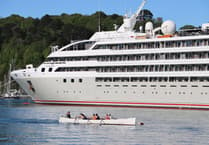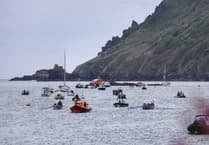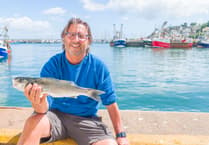This week I have been re-visiting the saltmarshes down Blanksmill Creek. Nigel Mortimer and Fiona Van Es, in their articles a few months ago were, like me, singing the praises of saltmarshes and saying how sensitive they are to trampling.
Blanksmill is a good place to enjoy finding all the different plants of a saltmarsh, without trampling on them and without having to walk far or get muddy, unless you want to. There is a small parking place just the Salcombe side of Blanksmill Bridge. If you leave your car there, you can walk back over the bridge, getting a fine view over the creek-top saltmarsh; the part closest to you is covered by the silvery-leaved, sea couch-grass.
Walk on across the bridge and in less than a hundred metres, on the right you come to a footpath, labelled Public Byway. Walk down the path and almost immediately, you can see a fine stand of sea club-rush waving by the Byway sign on the shore. Follow the shore line downstream for about two hundred yards and look carefully at the strip of vegetation on your left, at the top of the shore. You will see sea milkwort, sea spurrey, with flowers like stars, sea arrow-grass, whose pollen floats away in clouds of golden smoke if you touch it, and the tussocky clumps of saltmarsh sedge (whose photos were in last week’s article). You will also see sea purslane, a low-growing, bushy plant with silvery, oval leaves, which has increased since we first surveyed it twenty-five years ago. Can you spot it in the photo, looking back along the way we have come? After about 100metres the saltmarsh stops, by an old stone wall, until there is a clump of sea club-rush growing round an upstanding slate slab, covered in lichens. A fresh-water stream flows through it and weaves down through the mud to the main channel. After another 40 metres with almost no saltmarsh, there is a final considerable patch, with fine strips of sea club-rush, saltmarsh rush, saltmarsh sedge and sea couch-grass.
Unless you fancy a longer walk and getting a little muddy, here would be the place to turn round. This time concentrate on the muddy side, again looking left. Here we will see the pioneers, plants that can grow and thrive, on bare mud or shillet. There are patches of Spartina grass, a plant that twenty-five years ago only grew in Batson Creek on the Salcombe-Kingsbridge Estuary, although it is very common on many British estuaries, having spread, since about 1890, all around Britain. It arrived at Blanksmill about twenty years ago and has been spreading but not so fast or invasively as I had feared. Its tall, stiff leaves collect flotsam and silt and the plant speeds up the silting process. I used to help the school children remember its name by singing a version of one of Andrew Lloyd Weber’s songs, “Don’t cry for me Spartina, The truth is I never loved you.”
Glasswort is the traditional pioneer plant, There are several areas where it is growing out in the mud and at the edge of the saltmarsh but the most extensive is back at the head of the creek. Look across towards the far bank; over most of
the mud, there is a green sheen of filamentous green weed, from this is springing a sparce covering of glasswort, seablight and the beginnings of saltmarsh grass. This has doubled in size over the last twenty-five years.
For those who decide to take the challenge of a longer walk, there is a treat in store. Walk on past the slate slab and on to where you can see two spits almost meeting and the main channel weaving between them. Just beyond the spit is an old lime kiln, with an opening shaped like a church window. (Photo) From here you can see Rowden Point, which separates the mouths of Blanksmill and Collpit Creeks. For the last 100 metres before the point there is a thin strip of glasswort growing just below high tide mark. At the point, it expands into a broad triangle of glasswort stretching 30 metres down the shore. Please do not trample or disturb it as it is easily damaged.
As I used to explain to our children’s groups, to look closely at a saltmarsh is to enter a new and strange world, a completely different planet. What creatures might live hidden in these strange lands? Perhaps not Martians but there might be some Spartinans.











Comments
This article has no comments yet. Be the first to leave a comment.